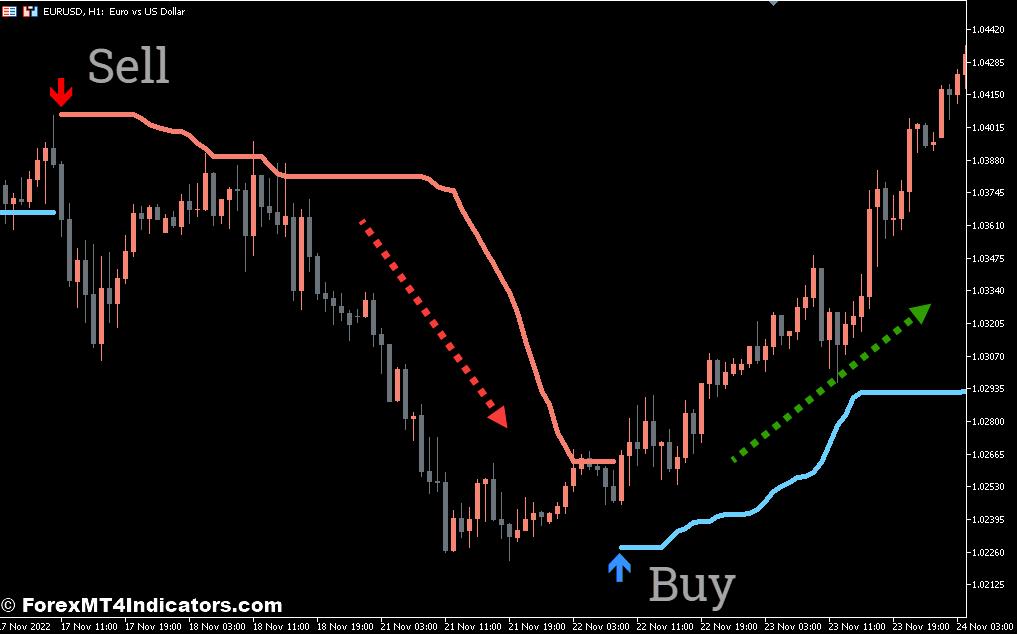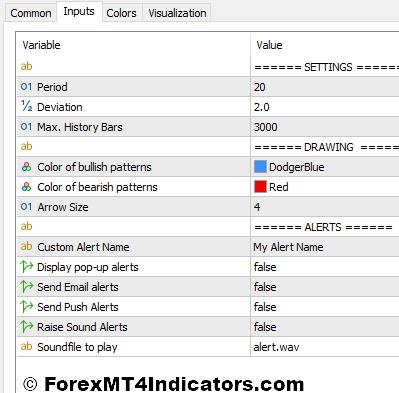The Point Zero Bollinger Trend is a custom indicator designed for the MT5 platform. It combines two well-established technical analysis tools: Bollinger Bands and fractals. By harnessing the strengths of both, this indicator aims to provide traders with clear signals for potential trend direction and price reversals.
Brief Overview of Bollinger Bands and Fractals
If you’ve spent any time exploring technical analysis, you’ve likely encountered Bollinger Bands. Developed by John Bollinger, these bands consist of a moving average (MA) line flanked by two outer bands. The distance between the bands is determined by a user-defined standard deviation, essentially reflecting market volatility. When the bands contract, it suggests a potential period of consolidation. Conversely, expanding bands often signal increased volatility and a possible breakout.
Fractals, on the other hand, are a technical indicator that identifies potential reversal points on a price chart. They are formed by a series of higher highs and lower lows, offering a visual cue for where the price might struggle to continue its current trajectory.
The Point Zero Bollinger Trend merges these two concepts, aiming to provide a more comprehensive picture of potential market behavior.
Understanding the Mechanics: How the Indicator Works
Now, let’s dissect the inner workings of this indicator.
The Moving Average (MA) Component
The Point Zero Bollinger Trend utilizes a moving average to establish a baseline for price action. This MA acts as the central line around which the Bollinger Bands are constructed. By default, the indicator often employs a simple moving average (SMA), but some variations might allow customization of the MA type (e.g., exponential moving average, EMA).
The Bollinger Band Integration
As mentioned earlier, the indicator incorporates Bollinger Bands. These bands are derived from the central MA, with their width determined by a user-defined standard deviation. As volatility increases, the bands expand, and vice versa. This dynamic interplay between price and the bands helps traders gauge potential price movements and identify potential breakout opportunities.
Fractals and Price Reversal Signals
The magic touch of the Point Zero Bollinger Trend comes from its integration of fractals. This indicator identifies these reversal points on the chart and often displays them with arrows or other visual cues. By combining the information gleaned from Bollinger Bands and fractals, the indicator aims to provide more robust signals for potential trend shifts and price reversals. In essence, the Point Zero Bollinger Trend attempts to marry the trend-following capabilities of moving averages with the volatility assessment of Bollinger Bands and the reversal identification power of fractals.
Advanced Strategies with the Indicator
While the core functionalities are valuable, the Point Zero Bollinger Trend can be integrated into more sophisticated trading strategies. Here are some examples:
Combining the Indicator with Other Technical Analysis Tools
The Point Zero Bollinger Trend is not meant to operate in isolation. Consider incorporating it with other technical indicators like the Relative Strength Index (RSI) or the Stochastic Oscillator to gain a more well-rounded perspective on market conditions. For instance, a bullish signal from the Point Zero Bollinger Trend might be strengthened by an oversold reading on the RSI, potentially indicating a buying opportunity.
Utilizing the Indicator for Scalping and Day Trading
Due to its potential for generating frequent signals, the Point Zero Bollinger Trend might be suitable for scalping and day trading strategies. However, it’s crucial to acknowledge the increased risk associated with these short-term trading approaches. Proper risk management techniques and a keen understanding of market dynamics are paramount for success in these fast-paced trading environments.
Fading Extremes and Identifying Exhaustion
When the price reaches the Bollinger Band extremes (upper or lower band), and the indicator displays a fractal in that zone, it could signal potential market exhaustion. This scenario might be interpreted as a fading opportunity, where traders enter short positions (sell) at the upper extreme or long positions (buy) at the lower extreme, anticipating a reversal towards the mean. However, exercising caution is vital, as these situations can also lead to false signals, especially in highly volatile markets.
Strengths and Weaknesses
Like any tool, the Point Zero Bollinger Trend has its own set of advantages and limitations. Let’s explore both sides of the coin.
Advantages of the Point Zero Bollinger Trend
- Simplicity: The indicator combines two well-understood technical analysis tools, making it potentially easier to grasp compared to more complex indicators.
- Multifaceted Analysis: By incorporating moving averages, Bollinger Bands, and fractals, the indicator offers a multi-dimensional view of potential trends and reversals.
- Customization: The ability to adjust various settings allows traders to tailor the indicator to their preferred trading style and market conditions.
Limitations and Potential Drawbacks
- Lag: Like many technical indicators, the Point Zero Bollinger Trend might suffer from lag, meaning it reacts to past price movements. This can be a disadvantage in fast-moving markets.
- False Signals: No indicator is perfect, and the Point Zero Bollinger Trend is no exception. There’s always a possibility of receiving false signals, particularly during periods of high volatility or choppy market conditions.
- Over-reliance: Solely relying on this indicator can be detrimental. It’s crucial to integrate it within a comprehensive trading strategy that incorporates other forms of market analysis and risk management techniques.
How to Trade with Point Zero Bollinger Trend Indicator

Buy Entry
- Trigger: Price breaks above the upper Bollinger Band with a confirmation fractal pointing upwards.
- Stop-Loss: Place a stop-loss order below the recent swing low (typically the low of the prior price bar).
Sell Entry
- Trigger: Price breaks below the lower Bollinger Band with a confirmation fractal pointing downwards.
- Stop-Loss: Place a stop-loss order above the recent swing high (typically the high of the prior price bar).
Point Zero Bollinger Trend Indicator Settings

Conclusion
Point Zero Bollinger Trend Indicator offers a promising tool for traders seeking to simplify trend analysis and identify potential reversals. While it boasts customization options and a multi-faceted approach, remember that no indicator is infallible. Lag and false signals can still occur, particularly in volatile markets. Utilize the Point Zero Bollinger Trend as a potential guide within a comprehensive trading strategy that prioritizes risk management and integrates other forms of market analysis.
By combining this indicator with your knowledge, experience, and cautious approach, you can potentially navigate the forex market with greater confidence and make informed trading decisions. So, equip yourself with the necessary tools and embark on your trading journey with a healthy dose of optimism and a commitment to continuous learning.
.png) InvestingStocksToolsClubsVideosPrivacy PolicyTerms And Conditions
InvestingStocksToolsClubsVideosPrivacy PolicyTerms And Conditions
